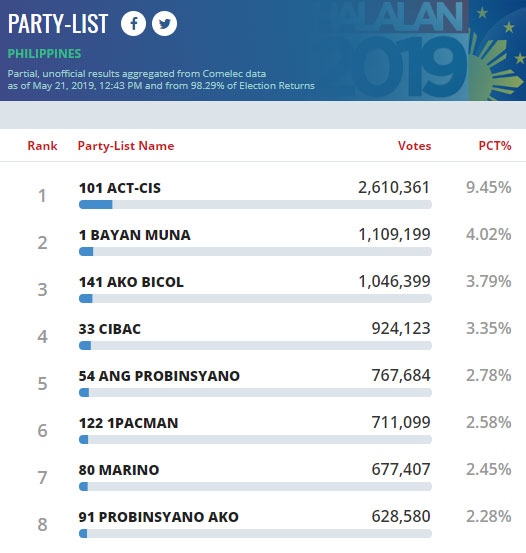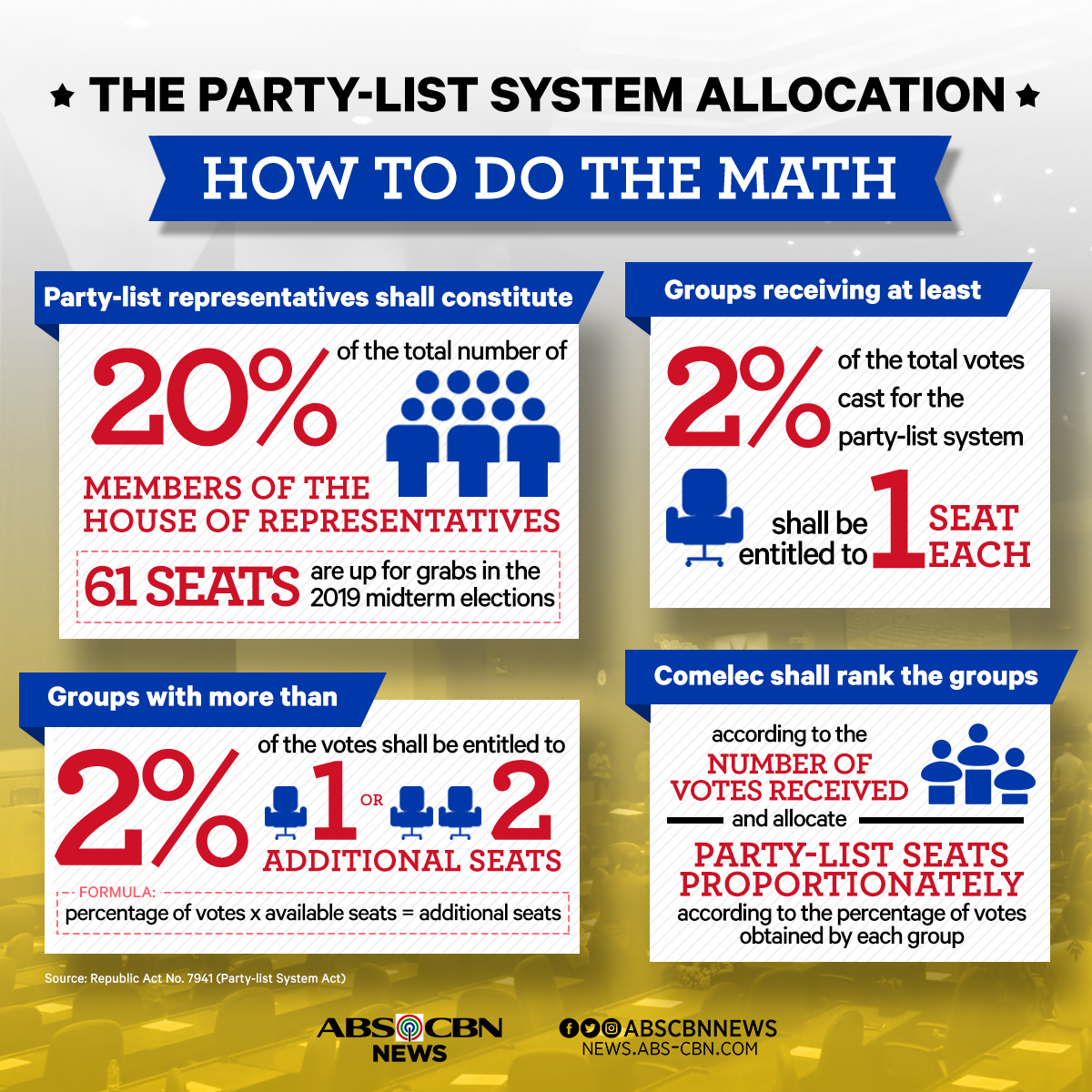EXPLAINER: The math behind the party-list system
ADVERTISEMENT

Welcome, Kapamilya! We use cookies to improve your browsing experience. Continuing to use this site means you agree to our use of cookies. Tell me more!
EXPLAINER: The math behind the party-list system
Michael Joe Delizo,
ABS-CBN News
Published May 21, 2019 09:25 PM PHT
|
Updated May 22, 2019 09:38 AM PHT
MANILA — The Commission on Elections (Comelec) is expected this week to proclaim party-list organizations that won in the recently concluded midterm polls.
MANILA — The Commission on Elections (Comelec) is expected this week to proclaim party-list organizations that won in the recently concluded midterm polls.
Conceived in the 1987 Constitution to provide representation for the marginalized and underrepresented, the Philippines’ party-list system allows voters to pick groups that would comprise 20 percent of the House of Representatives, or 61 seats in the 2019 elections, with the remaining 80 percent elected per legislative district.
Conceived in the 1987 Constitution to provide representation for the marginalized and underrepresented, the Philippines’ party-list system allows voters to pick groups that would comprise 20 percent of the House of Representatives, or 61 seats in the 2019 elections, with the remaining 80 percent elected per legislative district.
A party-list group that secures at least 2 percent of the total votes in the party-list race is entitled to at least 1 slot in the House during the first round of seat allocation.
A party-list group that secures at least 2 percent of the total votes in the party-list race is entitled to at least 1 slot in the House during the first round of seat allocation.
Based on partial, unofficial results aggregated from Comelec data, as of 12 p.m. of May 21, the groups that are poised to win the race are ACT-CIS (9.45 percent), Bayan Muna (4.02 percent), Ako Bicol (3.79 percent), Cibac (3.35 percent), Ang Probinsyano (2.78 percent), 1Pacman (2.58 percent), Marino (2.45 percent), and Probinsyano Ako (2.28 percent)
Based on partial, unofficial results aggregated from Comelec data, as of 12 p.m. of May 21, the groups that are poised to win the race are ACT-CIS (9.45 percent), Bayan Muna (4.02 percent), Ako Bicol (3.79 percent), Cibac (3.35 percent), Ang Probinsyano (2.78 percent), 1Pacman (2.58 percent), Marino (2.45 percent), and Probinsyano Ako (2.28 percent)
ADVERTISEMENT
Each of these 8 groups will be “guaranteed” at least one seat out of the total allocation.
Each of these 8 groups will be “guaranteed” at least one seat out of the total allocation.
These groups can still get additional seats based on the second-round formula: percentage of votes multiplied by the number of remaining seats.
These groups can still get additional seats based on the second-round formula: percentage of votes multiplied by the number of remaining seats.
“The first round of allocations will go to those who make 2 percent or better; [they] will get 1 guaranteed seat. We don’t say ‘qualified’, we say they are ‘guaranteed’. The rest of the seats, the balance of 61 minus guaranteed seats will then be distributed according to mathematical formula derived in Banat v. Comelec,” said Comelec spokesperson James Jimenez.
“The first round of allocations will go to those who make 2 percent or better; [they] will get 1 guaranteed seat. We don’t say ‘qualified’, we say they are ‘guaranteed’. The rest of the seats, the balance of 61 minus guaranteed seats will then be distributed according to mathematical formula derived in Banat v. Comelec,” said Comelec spokesperson James Jimenez.
For instance, the computation to determine how many more seats ACT-CIS, or Anti-Crime and Terrorism through Community Involvement and Support party-list, might be getting is this: 9.45 percent x 53 equals 5 seats.
For instance, the computation to determine how many more seats ACT-CIS, or Anti-Crime and Terrorism through Community Involvement and Support party-list, might be getting is this: 9.45 percent x 53 equals 5 seats.
Under the law, however, a party-list group can only get as many as 3 seats. Thus, Duterte-backed ACT-CIS is expected to have all its 3 nominees Eric Yap, Jocelyn Tulfo, and Rowena Niña Taduran in the House.
Under the law, however, a party-list group can only get as many as 3 seats. Thus, Duterte-backed ACT-CIS is expected to have all its 3 nominees Eric Yap, Jocelyn Tulfo, and Rowena Niña Taduran in the House.
ADVERTISEMENT
As of this writing, left-leaning Bayan Muna and regional party Ako Bicol are also expected to have 3 seats, while Cibac, Ang Probinsyano, 1Pacman, Marino, and Probinsyano Ako might get 2 seats each.
As of this writing, left-leaning Bayan Muna and regional party Ako Bicol are also expected to have 3 seats, while Cibac, Ang Probinsyano, 1Pacman, Marino, and Probinsyano Ako might get 2 seats each.
The rest of the seats will then be distributed to 126 remaining groups based on ranking in order to fill up the 20-percent House membership allocation for the party-list system.
The rest of the seats will then be distributed to 126 remaining groups based on ranking in order to fill up the 20-percent House membership allocation for the party-list system.
“After all of the guaranteed seats have been given additional allocations of either 2 or 1, then the rest of the seats will then be apportioned to the remaining party-list organizations in descending order.
“After all of the guaranteed seats have been given additional allocations of either 2 or 1, then the rest of the seats will then be apportioned to the remaining party-list organizations in descending order.
“You will have party-list organizations with seat in Congress who might have less than a million votes or perhaps even less than 500,000 votes because we will distribute whatever seats are available out of the 61, all the way down the ranking,” said Jimenez.
“You will have party-list organizations with seat in Congress who might have less than a million votes or perhaps even less than 500,000 votes because we will distribute whatever seats are available out of the 61, all the way down the ranking,” said Jimenez.
Read More:
Halalan 2019
party-list
ACT-CIS
Bayan Muna
Ako Bicol
Cibac
Ang Probinsyano
1Pacman
Marino
Probinsyano Ako
ADVERTISEMENT
ADVERTISEMENT




